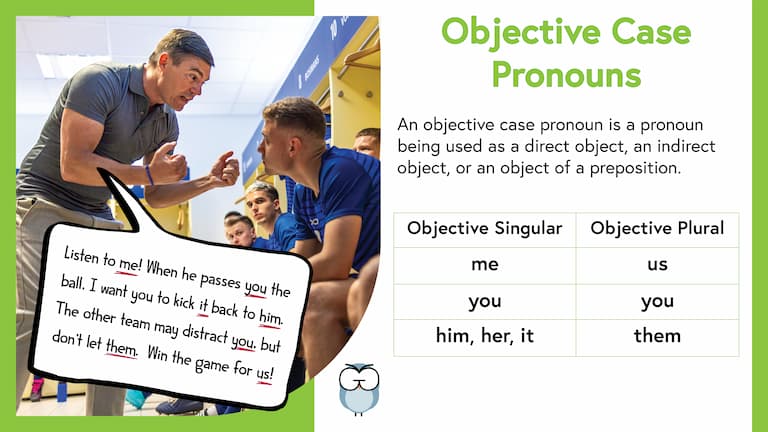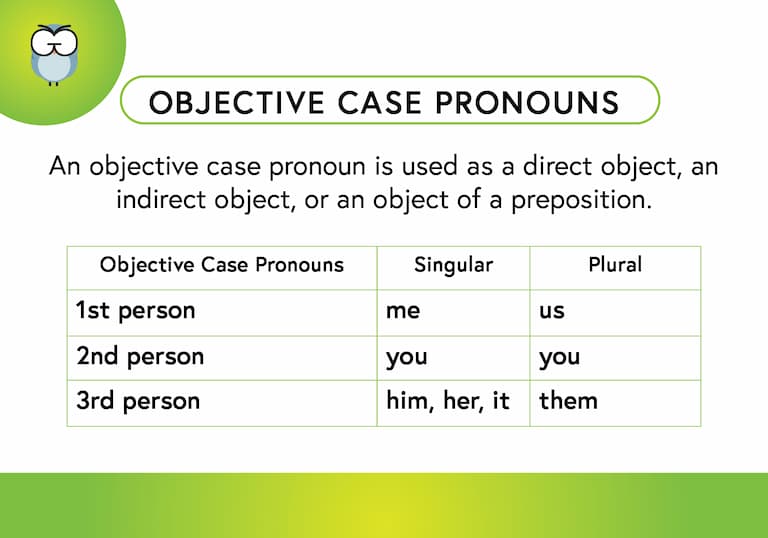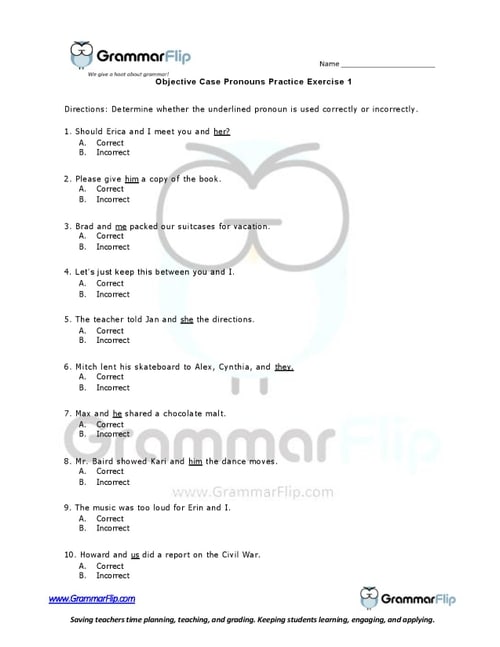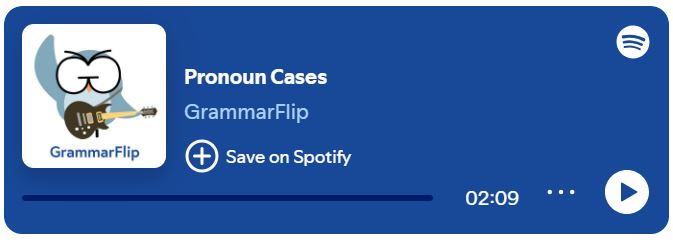What is an Objective Case Pronoun?
An objective case pronoun is a pronoun being used as a direct object, an indirect object, or an object of a preposition. These include me, you, him, her, it, us, and them.
Some examples of objective case pronouns would be the following:
An objective case pronoun as a direct object:
Justin drove me to school this morning.
I can help you with your homework.
An objective case pronoun as an indirect object:
Riley lent him a pencil before the test.
Michelle baked them a cake.
An objective case pronoun as the object of a preposition:
You can leave your jacket with us and pick it up after the show.
Jade’s dress was sewn by her and her mother.
Long-Form Videos: Objective Case Pronouns
Long-form instructional video lessons allow students to engage with grammar concepts in more depth and detail.
This format provides students with a stronger foundation and a more comprehensive understanding of objective case pronouns.
Short-Form Videos: Objective Case Pronouns
Short-form videos are an excellent way to review grammar concepts. Our two-minute instructional videos help students review the concept of objective case pronouns to further solidify their understanding.
Memorable Images: Objective Case Pronouns

The use of images to connect visual cues with concepts makes it simpler for students to grasp and remember key ideas. GrammarFlip’s memorable images create visual associations that make objective case pronouns more engaging and easier to retain.
Definition Cards: Objective Case Pronouns
Definition cards reinforce grammar concepts by providing clear and concise explanations that students can easily reference for quick review and better retention. GrammarFlip’s definintion cards help students review the concept of objective case pronouns to further solidify their understanding.

Music: Objective Case Pronouns
Learn grammar concepts through music! The unique verses and catchy chorus in our “Pronoun Cases Song” will help your students further understand objective case pronouns. Listen for yourself and see if you don’t walk away singing this song to yourself!
Listen to GrammarFlip Music via Spotify, Apple, or Amazon!
Music Videos: Objective Case Pronouns
Music videos make grammar concepts more engaging and memorable by combining rhythm, visuals, and repetition to reinforce learning. GrammarFlip’s music videos help students retain the concept of objective case pronouns more effectively while making the learning process fun and interactive.
Why You Should Use Objective Case Pronouns in Your Writing
Objective case pronouns (like all pronouns) should be used to avoid repetition and redundancy.
Keep in mind that these are objective case pronouns (as opposed to nominative case pronouns or possessive case pronouns). Objective case pronouns can only be used as the direct object, indirect object, or as the object of a preposition in a sentence.
Download a Free Worksheet on Objective Case Pronouns!
Click the image below to download your free worksheet on objective case pronouns!

Need something more than just worksheets for your grammar instruction?
Explore More GrammarFlip Lessons!
Parts of Speech lessons provide the building blocks of grammar. GrammarFlip covers these topics in detail to ensure a solid foundation is built. First time learners and students seeking to review the parts of speech can both benefit from the instructional videos and slide show reviews.
Parts of the Sentence lessons are critical for understanding how the parts of speech function in language construction. From the basic to the advanced, these lessons will cover a wide range of grammar topics that can be used in any grade level or classroom.
Mechanics and Usage lessons equip students with the necessary skills to communicate clearly to all audiences. With a focus on the application of these concepts in student writing, these lessons tie together both simple constructions of grammar as well as the more complex such that any age or skill level of student will benefit.



